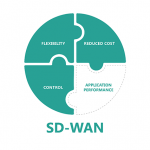Google brings AI collaboration to work

Google used yesterday's Google I/O to announce new services and capabilities across Google Cloud and Workspace.
Among these is Duet AI, an AI-powered collaborator, to enable more users and developers to start seeing the impact AI can have on their organization and help solve day-to-day work challenges.
Exploring the potential of cloud PCs for strategic cost rationalization

The introduction of advanced technologies has opened a world of possibilities for global corporate growth. The problem is that IT department budgets continue to be constrained, limiting the scope of technology investments at large.
This means that business leaders need to innovate to be prepared for changing business conditions. Advancing their digital transformation roadmaps should take priority as this will likely provide the greatest return on IT investment since the technology choices they make today will have a major impact on future success.
Should IT chiefs be wary of vendor lock-in when moving to the cloud? [Q&A]

In the dash to move systems to the cloud it's easy to become dependent on the services of a specific vendor, making it time-consuming or costly to move to an alternative at a later date.
We spoke to Cooper Lutz, chief architect, digital solutions at AHEAD, to get his advice for IT teams making their way to the cloud on the best practices to mitigate vendor lock-in.
Enterprise IT leaders plan to cut cloud spending

A new study from Vega Cloud on the use of cloud software and services by enterprise IT executives shows 48 percent expect to reduce their IT spending a little or a lot in 2023.
In addition, 65 percent say that reducing their cloud spending will be a goal for this year, while three-quarters of IT execs surveyed say they plan to cut cloud costs by between 10 and 50 percent in 2023.
How SD-WAN and Public Cloud have changed the dynamics when it comes to modern connectivity and infrastructure requirements

Digital and cloud transformation has unlocked new business opportunities and operational efficiencies for organizations. But migration to the cloud also means our approach to deploying applications and services has radically changed, as enterprises move away from traditional data centers. Likewise, flexible working means users have also moved away from traditional offices and branches.
As a result, organizations that were once heavily dependent on MPLS (multi-protocol label switching) have either moved, or are moving, away and it has lost its dominance. Today, many organizations have either deployed, or are looking to deploy, SD-WAN over the internet. However, the move away from MPLS to an internet-based SD-WAN solution means that some global organizations are now struggling with the performance of their inter-region connectivity. Using the internet between regions – across longer distances and where applications are not locally hosted – can present issues.
Ubuntu Pro becomes available on the AWS EC2 console

Ubuntu Pro is now available in a subscription-included model on Amazon Web Services (AWS), allowing users to launch Ubuntu Pro on-demand instances and purchase Ubuntu Pro Compute Savings Plans from the Amazon Elastic Compute Cloud (Amazon EC2) console.
Users will be able to run Ubuntu machines with expanded security maintenance, kernel live patch, and hardening scripts out of the box with all of these features enabled by default.
Integration is a top priority for enterprises

A new report finds that 71 percent of enterprises are actively planning to implement integration technology this year.
The study from enterprise integration platform as a service (iPaaS) company Digibee surveyed over 1,000 US and Canada-based CIOs, CTOs, developers, and enterprise architects, and finds integration strategies being hampered by technology that isn't cloud-native and lack the agility to respond quickly.
Google Authenticator gains cloud backup of one-time codes

Google has released an important update for its Authenticator app. The latest versions of Google Authenticator for iOS and Android can now synchronize one-time codes to the cloud.
In offering Google Account synchronization, the 2FA tool is now easier to use across multiple devices. This is something Google points out as being useful in the case of a lost or stolen device.
Why Hybrid Cloud is here to stay

Cloud has completely changed how contemporary businesses operate. It gives organizations a scalable means of managing their infrastructure, applications, and data. Between its flexibility and Pay as You Go (PAYG) options, Cloud provides substantially more configuration and design options than traditional infrastructure. As a result, businesses are adopting cloud services more and more frequently, giving them access to new tools and technologies, while also yielding efficiency improvements for their operations and procedures.
According to some projections, the worldwide cloud services industry will be worth about $600 billion by 2023, generating a rapidly expanding need for hybrid and multi-cloud solutions. Gartner expects that cloud system infrastructure services will be the second-biggest, but fastest-growing, cloud expenditure market category in 2023. As illustrated by the projected increase, hybrid and multi-cloud computing is becoming the new normal for many organizations -- providing them with the scalability benefits of public cloud -- while also delivering the flexibility and control inherent in private cloud computing and traditional server infrastructure.
New tool makes it easier to manage machine identities

Thanks to increased cloud and container use there's a growing demand for machine identities, but delivering and managing those identities can present problems.
Machine ID specialist Venafi is launching a new tool called Firefly that enables security teams to easily and securely meet developer-driven machine identity management requirements for cloud native workloads by issuing machine identities, such as TLS and SPIFFE, locally and quickly across any environment.
What if cloud data was stored on floppy disks?
Enterprises plan to increase cloud service investment as part of network transformation

In a drive for network transformation, 98 percent of enterprise IT leaders say they plan to increase their dependence and investment in cloud services.
The latest Enterprise Network Transformation report from SASE solutions company Aryaka finds that although an uncertain economy is impacting network and security team investments CIOs, CISOs and IT leaders are doubling down on investment in the cloud.
New solution offers cheaper enterprise-grade cloud storage

A new enterprise-grade, native cloud storage solution aims to deliver increased speed, affordability and security thanks to its use of decentralized Web3 technology.
Impossible Cloud supports almost unlimited capacity, and its Object Storage solution offers a scalable, cost-efficient alternative for organizations that require reliable and secure storage.
Why have cloud when you can have supercloud? [Q&A]

There's been a lot of talk about 'supercloud' recently, but what exactly does it mean? And is it the next big thing that's set to disrupt the technology landscape?
We talked to Amir Khan, CEO and co-founder of Alkira, to find out more about supercloud and what it means for the industry.
Strong data protection can deliver economic benefits for enterprises

As enterprises move to cloud and hybrid models they face a range of new challenges in protecting their data.
A new study from Enterprise Strategy Group (ESG), released by Commvault and Microsoft, finds that 53 percent of respondents say their IT environment was more complex than it was two years ago.
Recent Headlines
BetaNews, your source for breaking tech news, reviews, and in-depth reporting since 1998.
© 1998-2025 BetaNews, Inc. All Rights Reserved. About Us - Privacy Policy - Cookie Policy - Sitemap.
